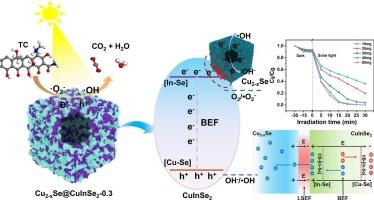Cu2-xSe@CuInSe2 hollow cage catalyst for efficient visible light degradation of antibiotics based on electric field co-regulation of charge directional transport
IF 4.7
3区 化学
Q2 CHEMISTRY, PHYSICAL
Journal of Photochemistry and Photobiology A-chemistry
Pub Date : 2025-09-15
DOI:10.1016/j.jphotochem.2025.116769
引用次数: 0
Abstract
The design and construction of a new hollow caged selenide for the degradation of refractory antibiotics in surface water is an effective way to improve the efficiency of solar energy utilization, but early photocatalysts often face problems such as high recombination efficiency of photogenerated carriers and slow transport kinetics. In this study, an asymmetric Cu2-xSe nanocomposite catalyst modified with hollow caged structure CuInSe2 was successfully constructed, in which the empty structure promotes the rapid directional transport of photogenerated charges through the synergistic effect of bulk electric field (BEF) and local surface electric field (LSEF). Photogenerated electrons are directed from the [Cu![]() Se] region through the [In
Se] region through the [In![]() Se] region and migrate directionally to the hollow caged Cu2-xSe surface. In the Cu2-xSe@CuInSe2–0.3 catalyst system, the degradation efficiency of tetracycline (TC) can reach 95.8 % within 30 min, and the rate constant is 0.11 min−1, which is 8.5 times and 12.6 times that of Cu2-xSe and CuInSe2, respectively. The characterization results and density functional theory (DFT) calculations show that the photocatalytic activity driven by visible light is significantly improved by directionally guiding the charge transport path and enhancing the light absorption properties, providing a new idea for the development of refractory wastewater treatment and wheat growth environment.
Se] region and migrate directionally to the hollow caged Cu2-xSe surface. In the Cu2-xSe@CuInSe2–0.3 catalyst system, the degradation efficiency of tetracycline (TC) can reach 95.8 % within 30 min, and the rate constant is 0.11 min−1, which is 8.5 times and 12.6 times that of Cu2-xSe and CuInSe2, respectively. The characterization results and density functional theory (DFT) calculations show that the photocatalytic activity driven by visible light is significantly improved by directionally guiding the charge transport path and enhancing the light absorption properties, providing a new idea for the development of refractory wastewater treatment and wheat growth environment.

Cu2-xSe@CuInSe2基于电场协同调控电荷定向输运的抗生素可见光高效降解空心笼催化剂
设计和构建用于地表水中难降解抗生素的新型中空笼型硒化物是提高太阳能利用效率的有效途径,但早期的光催化剂往往面临光生载体重组效率高、传输动力学慢等问题。本研究成功构建了一种以空心笼状结构CuInSe2修饰的不对称Cu2-xSe纳米复合催化剂,其中空心笼状结构通过体电场(BEF)和局部表面电场(LSEF)的协同作用促进光生电荷的快速定向输运。光生电子从[CuSe]区穿过[InSe]区,定向迁移到空心笼状Cu2-xSe表面。在Cu2-xSe@CuInSe2 -0.3催化剂体系中,四环素(TC)在30 min内的降解效率可达95.8%,速率常数为0.11 min−1,分别是Cu2-xSe和CuInSe2的8.5倍和12.6倍。表征结果和密度泛函理论(DFT)计算表明,定向引导电荷输运路径和增强光吸收性能显著提高了可见光驱动下的光催化活性,为难降解废水处理和小麦生长环境的开发提供了新的思路。
本文章由计算机程序翻译,如有差异,请以英文原文为准。
求助全文
约1分钟内获得全文
求助全文
来源期刊
CiteScore
7.90
自引率
7.00%
发文量
580
审稿时长
48 days
期刊介绍:
JPPA publishes the results of fundamental studies on all aspects of chemical phenomena induced by interactions between light and molecules/matter of all kinds.
All systems capable of being described at the molecular or integrated multimolecular level are appropriate for the journal. This includes all molecular chemical species as well as biomolecular, supramolecular, polymer and other macromolecular systems, as well as solid state photochemistry. In addition, the journal publishes studies of semiconductor and other photoactive organic and inorganic materials, photocatalysis (organic, inorganic, supramolecular and superconductor).
The scope includes condensed and gas phase photochemistry, as well as synchrotron radiation chemistry. A broad range of processes and techniques in photochemistry are covered such as light induced energy, electron and proton transfer; nonlinear photochemical behavior; mechanistic investigation of photochemical reactions and identification of the products of photochemical reactions; quantum yield determinations and measurements of rate constants for primary and secondary photochemical processes; steady-state and time-resolved emission, ultrafast spectroscopic methods, single molecule spectroscopy, time resolved X-ray diffraction, luminescence microscopy, and scattering spectroscopy applied to photochemistry. Papers in emerging and applied areas such as luminescent sensors, electroluminescence, solar energy conversion, atmospheric photochemistry, environmental remediation, and related photocatalytic chemistry are also welcome.

 求助内容:
求助内容: 应助结果提醒方式:
应助结果提醒方式:


